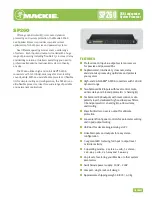Design Considerations
(Continued)
Designs using the HPC family of 16-bit high speed CMOS
microcontrollers need to follow some general guidelines on
usage and board layout.
Floating inputs are a frequently overlooked problem. CMOS
inputs have extremely high impedance and, if left open, can
float to any voltage. You should thus tie unused inputs to
V
CC
or ground, either through a resistor or directly. Unlike
the inputs, unused output should be left floating to allow the
output to switch without drawing any DC current.
To reduce voltage transients, keep the supply line’s parasit-
ic inductances as low as possible by reducing trace lengths,
using wide traces, ground planes, and by decoupling the
supply with bypass capacitors. In order to prevent additional
voltage spiking, this local bypass capacitor must exhibit low
inductive reactance. You should therefore use high frequen-
cy ceramic capacitors and place them very near the IC to
minimize wiring inductance.
X
Keep V
CC
bus routing short. When using double sided or
multilayer circuit boards, use ground plane techniques.
X
Keep ground lines short, and on PC boards make them as
wide as possible, even if trace width varies. Use separate
ground traces to supply high current devices such as re-
lay and transmission line drivers.
X
In systems mixing linear and logic functions and where
supply noise is critical to the analog components’ per-
formance, provide separate supply buses or even sepa-
rate supplies.
X
If you use local regulators, bypass their inputs with a tan-
talum capacitor of at least 1
m
F and bypass their outputs
with a 10
m
F to 50
m
F tantalum or aluminum electrolytic
capacitor.
X
If the system uses a centralized regulated power supply,
use a 10
m
F to 20F tantalum electrolytic capacitor or a
50
m
F to 100
m
F aluminum electrolytic capacitor to de-
couple the V
CC
bus connected to the circuit board.
X
Provide localized decoupling. For random logic, a rule of
thumb dictates approximately 10 nF (spaced within
12 cm) per every two to five packages, and 100 nF for
every 10 packages. You can group these capacitances,
but it’s more effective to distribute them among the ICs. If
the design has a fair amount of synchronous logic with
outputs that tend to switch simultaneously, additional de-
coupling might be advisable. Octal flip-flop and buffers in
bus-oriented circuits might also require more decoupling.
Note that wire-wrapped circuits can require more decou-
pling than ground plane or multilayer PC boards.
A recommended crystal oscillator circuit to be used with the
HPC is shown in
Figure 29 . See table for recommended
component values. The recommended values given in
Table V have yielded consistent results and are made to
match a crystal with a 20 pF load capacitance, with some
small allowance for layout capacitance.
A recommended layout for the oscillator network should be
as close to the processor as physically possible, entirely
within 1
×
distance. This is to reduce lead inductance from
long PC traces, as well as interference from other compo-
nents, and reduce trace capacitance. The layout contains a
large ground plane either on the top or bottom surface of
the board to provide signal shielding, and a convenient loca-
tion to ground both the HPC, and the case of the crystal.
It is very critical to have an extremely clean power supply for
the HPC crystal oscillator. Ideally one would like a V
CC
and
ground plane that provide low inductance power lines to the
chip. The power planes in the PC board should be decou-
pled with three decoupling capacitors as close to the chip
as possible. A 1.0
m
F, a 0.1F, and a 0.001F dipped mica or
ceramic cap should be mounted as close to the HPC as is
physically possible on the board, using the shortest leads,
or surface mount components. This should provide a stable
power supply, and noiseless ground plane which will vastly
improve the performance of the crystal oscillator network.
TABLE V. HPC Oscillator
XTAL
Frequency
R
1
(
X
)
(MHz)
2
1500
4
1200
6
910
8
750
10
600
12
470
14
390
16
300
18
220
20
180
22
150
24
120
26
100
28
75
30
62
R
F
e
3.3 M
X
C
1
e
27 pF
C
2
e
33 pF
XTAL Specifications: The crystal used was an M-TRON Industries MP-1 Se-
ries XTAL. ‘‘AT’’ cut, parallel resonant.
C
L
e
20 pF
Series Resistance is
25
X
@
25 MHz
40
X
@
10 MHz
600
X
@
2 MHz
TL/DD/11046 – 37
FIGURE 29. Recommended Crystal Circuit
27
Summary of Contents for HPC167064
Page 19: ...TL DD 11046 26 FIGURE 18 Block Diagram of Interrupt Logic 19 ...
Page 33: ...33 ...

















